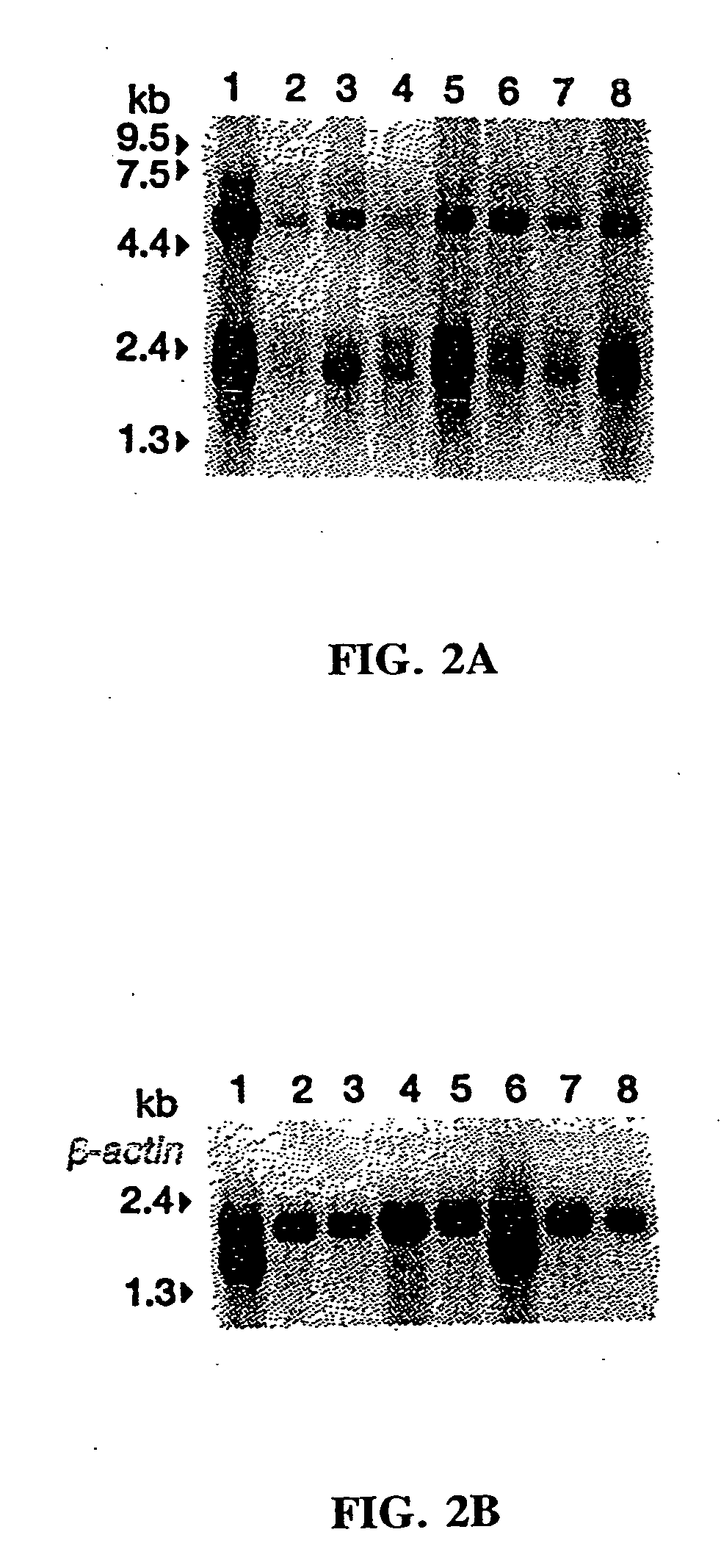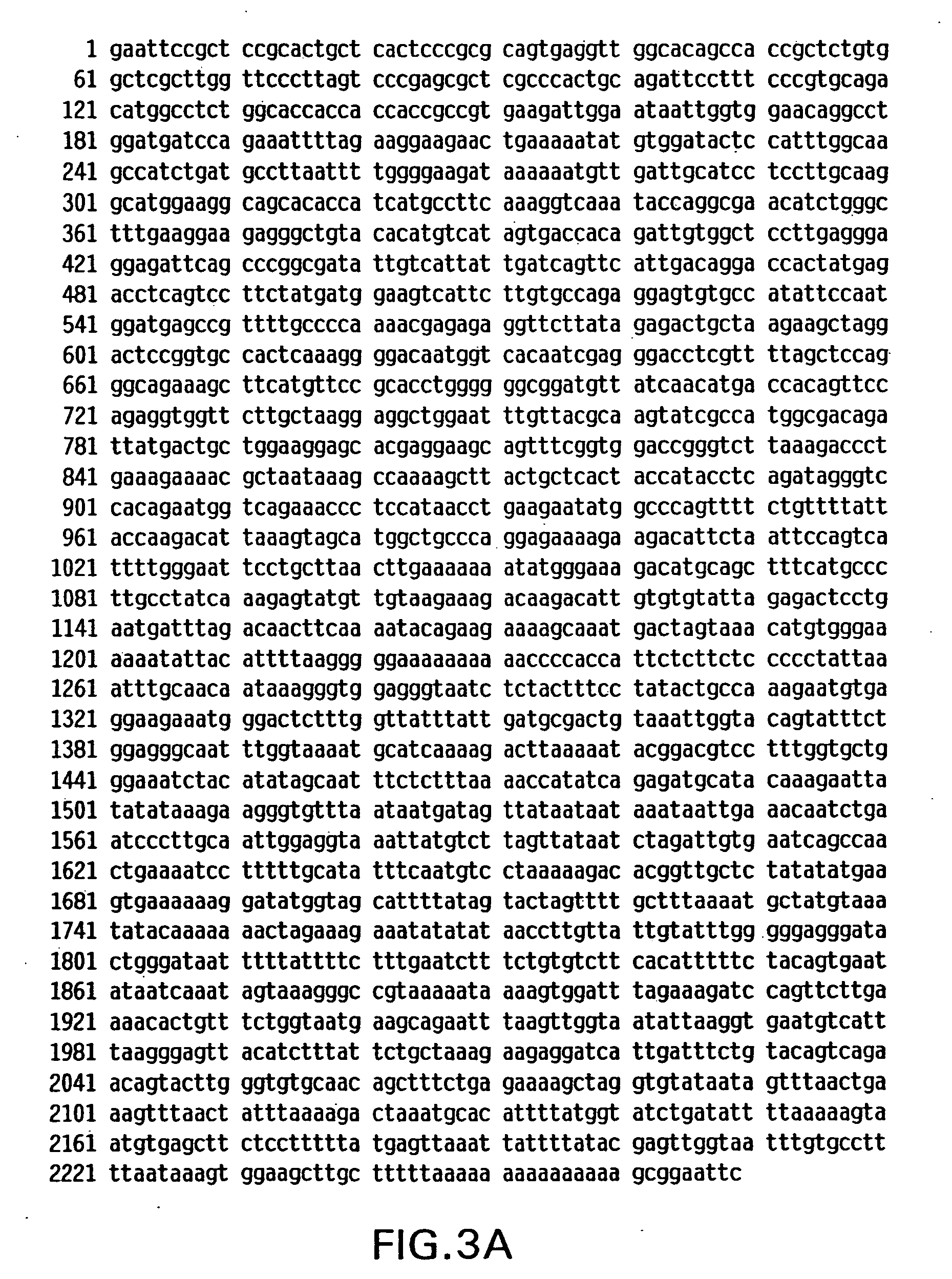Methylthioadenosine phosphorylase compositions and methods of use in the diagnosis and treatment of proliferative disorders
a technology of methylthioadenosine phosphorylase and composition, which is applied in the field of molecular biology, can solve the problems of difficult to determine the exact position of the mtap gene in relation, low frequency of point mutations of this gene in hematological malignancies, and high frequency of breakage gaps at fragile sites
- Summary
- Abstract
- Description
- Claims
- Application Information
AI Technical Summary
Benefits of technology
Problems solved by technology
Method used
Image
Examples
example 1
5.1 Example 1
Construction of a 2.8 Mb YAC Contig and Cloning of the Human MTAP Gene from the Tumor Suppressor Region on 9p21
[0167] This example describe the construction of a long range physical map around the IFN gene cluster which covers a distance of 2.8 Mb as determined by pulsed-field gel electrophoresis and also the isolation of the MTAP gene cDNA. All of the known genes were localized as well as several CpG islands on this map. Restriction sites and pulsed field fragment sizes are clearly delineated on the resultant map which extends further proximally than the one previously presented (Weaver-Feldhaus et al., 1994) In addition, several new markers are described and localized on this map. The approximate location of the shortest region of overlap of 9p deletions in gliomas, melanomas, lung cancer, leukemia, mesothelioma, head and neck cancer and bladder cancers in relation to this map is indicated.
5.1.1 Materials and Methods
5.1.1.1 Cell Lines
[0168] The clinical and cyto...
example 2
5.2 Example 2
Mapping of Genomic Rearrangements Involving the Short Arm of Chromosome 9 in ALL and Other Hematologic Malignancies
5.2.1 Material and Methods
5.2.1.1 Patients
[0183] The karyotypes of patients with hematological malignancies referred to the Cytogenetic Hematology / Oncology Laboratory of the University of Chicago Medical Center between 1989 and 1994 were reviewed. Twenty cases with cytogenetic rearrangement of the short arm of chromosome 9 in at least 30% of the metaphase cells analyzed and for which material were available were selected. Cytogenetically, 7 cases had a rearrangement that involved no loss of band 9p21, 9 cases retained one copy and 4 cases had homozygous deletions of chromosomal band 9p21. Each case (13 ALL, 2 AML, 5 NHL) was classified according to the criteria of the French-American-British (FAB) classification for leukemias or the working formulation for the non-Hodgkin's lymphomas (Non Hodgkin's Lymphoma Pathologic Classification Project, 1982; Benn...
example 3
5.3 Example 3
Detection of CDKN2 Deletions in Tumor Cell Lines and Primary Glioma by Interphase FISH
[0199] This example demonstrates interphase FISH analysis on 10 tumor-derived cell lines (4 glioma, 2 melanoma, 2 non-small cell lung cancer, 2 bladder cancer) with rearrangement of the short arm of chromosome 9 detected by molecular or cytogenetic analysis and 9 primary glioblastoma, to determine the accuracy of different probes in detecting 9p deletions in tumor cell lines and primary tumor tissue. The example illustrates the utility of interphase FISH to detect deletions of the CDKN2 region in primary tumors.
5.3.1 Materials and Methods
5.3.1.1 Cell Lines
[0200] 10 cell lines were used (4 glioma, 2 melanoma, 2 non-small cell lung carcinoma, and 2 bladder cancer) that had been well characterized by conventional cytogenetic analysis. The cell lines were obtained from the American Type Culture Collection or from the investigators who had established them. Cytogenetic deletions of th...
PUM
| Property | Measurement | Unit |
|---|---|---|
| temperatures | aaaaa | aaaaa |
| temperatures | aaaaa | aaaaa |
| temperatures | aaaaa | aaaaa |
Abstract
Description
Claims
Application Information
 Login to View More
Login to View More - R&D
- Intellectual Property
- Life Sciences
- Materials
- Tech Scout
- Unparalleled Data Quality
- Higher Quality Content
- 60% Fewer Hallucinations
Browse by: Latest US Patents, China's latest patents, Technical Efficacy Thesaurus, Application Domain, Technology Topic, Popular Technical Reports.
© 2025 PatSnap. All rights reserved.Legal|Privacy policy|Modern Slavery Act Transparency Statement|Sitemap|About US| Contact US: help@patsnap.com



